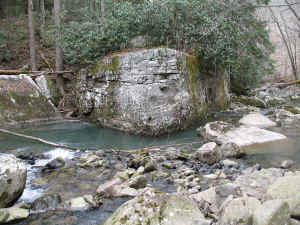| ENTS
Recently
Jess Riddle and I revisited the Savage Creek drainage in the
Savage Gulf State Natural Area. We had been shown the
"Still Hollow" area of the Savage Creek Gorge last
year by Tom Simpson with the state of Tennessee, who guided us
to some of the state champion trees there. During our last
visit, the leaves were out in full force, which made measuring
very difficult; the forest is densely packed and very tall. The
report from last time, which describes the area, is at:
http://www.nativetreesociety.org/fieldtrips/tennessee/savage_gulf/savage_gulf05.htm
.
During this
last visit the canopy was leafless (except the hemlocks), which
helped with the measuring. We spent two days around the middle
section of Savage Creek and there is still a great deal of
territory to cover.
Photos from Savage Gulf. by Michael Davie

A panoramic shot from the plateau across Savage Creek
The tall trees extend from the creek to just
below the cliffs along the rim very consistently, and though
there are some spots with shorter trees, the tall trees are
generally everywhere on the south side of the creek, with some
on the north side as well. It will be very interesting to
explore some of the other areas downstream where the drainage
widens, and the elevation drops. The sheltering effect might
lessen overall, but there is still enough topographic
variability to create many niches for height, and some species
may do better, as well as new ones popping up.

Angle is kind of odd, but I like it, it shows the normal incline of Savage Gulf |

Lick Creek is interesting. Jess and I saw a cave across the creek with a stream
flowing out. Apparently part of Lick Creek sinks |

Sycamore growing in the middle of Savage Creek. |

The very top of Still Hollow going into the Savage Creek Gulf |
Species Cbh Height
Ash, Green 10'2" 113.2'
Ash, Green 6'7.5"
132.6'
Ash, Green 9'4" 143.4'
Ash, Green 8'6" 143.9'
Basswood, White NA 124.4'
Basswood, White NA 127.5'
Basswood, White NA 134.0'
Basswood, White 5'9" 134.4'
Basswood, White 9'4" 135.1'
Basswood, White 6'9" 136.0'
Basswood, White 9'7" 137.8'
Basswood, White 10'6" 140.6'
Basswood, White 8'1.5"
141.9'
Basswood, White NA 146.7'
Basswood, White 10'2" 146.7'
Basswood, White 10'3" 151.7'
Beech, American 7'3" 123.4'
Beech, American 7'1" 143.2'
Buckeye, Yellow NA 121.3'
Buckeye, Yellow 6'4" 126.8'
Buckeye, Yellow 9'10" 129.9'
Buckeye, Yellow 9'1" 136.0'
Elm, American 8'7" 136.5'
Elm, American 8'10" 137.6'
Hemlock, Eastern NA 131.4'
Hemlock, Eastern NA 137.2'
Hemlock, Eastern 10'0.5"
140.5'
Hemlock, Eastern NA 142.2'
Hemlock, Eastern 9'0" 156.5'
Hophornbean, Eastern 2'6" 71.1'
Hickory, Bitternut 5'10.5"
126.9'
Hickory, Bitternut NA 133.1'
Hickory, Bitternut 6'9" 138.4'
Hickory, Pignut 7'2" 136.5'
Hickory, Pignut NA 141.3'
Hickory, Pignut 9'3" 144.9'
Hickory, Pignut 6'0" 147.0'
Hickory, Pignut 5'1" 147.6'
Hickory, Pignut 9'8" 153.1'
Hickory, Pignut 9'1" 154.7'
Hickory, Pignut 9'7" 157.9'
Hickory, Shagbark 6'8" 139.7'
Hickory, Shagbark NA 142.8'
Hickory, Shagbark 9'6" 145.3'
Hickory, Shagbark 6'10.5"
146.6'
Hickory, Shagbark NA 147.1'
Hickory, Shagbark 7'6.5"
148.2'
Hickory, Shagbark 9'1" 148.4'
Hickory, Shagbark 7'0.5"
152.6'
Hickory, Shagbark 5'8.5"
154.4'
Magnolia, Cucumber NA 130.1'
Magnolia, Cucumber 14'0" 135.3'
Magnolia, Cucumber 7'4" 136.1'
Magnolia, Cucumber 7'5.5" 140.6'
Magnolia, Cucumber 6'4" 141.1'
Magnolia, Cucumber 9'1.5" 141.7'
Magnolia, Cucumber 6'6" 147.3'
Maple, Red 7'2" 122.9'
Maple, Sugar NA 126.8'
Maple, Sugar 10'6" 135.4'
Maple, Sugar 9'0" 136.0'
Oak, Chestnut 9'2" 138.8'
Oak, Chestnut 8'11" 139.6'
Oak, Northern Red 6'0" 133.1'
Oak, White 7'10" 126.9'
Sweetgum 7'1" 150.1'
Sycamore 12'9" ~120'
Tuliptree NA 144.2'
Tuliptree NA 147.9'
Tuliptree NA 148.0'
Tuliptree 16'9" 149.0'
Tuliptree NA 151.0'
Tuliptree 9'9" 152.7'
Tuliptree NA 156.7'
Tuliptree 6'10" 160.9'
Tuliptree NA 161.4'
Yellowwood NA 71.1'
Yellowwood NA 77.2'
Rucker Index 152.45'
Pignut Hickory 162.3'
Tuliptree 161.4'
Eastern Hemlock 156.5'
Shagbark Hickory 154.4'
White Basswood 151.7'
Northern Red Oak 150.1'
Sweetgum
150.1'
Cucumber Magnolia 147.3'
Mockernut Hickory 146.8'
Green Ash 143.9'

Prow- Savage Creek |

Typical rocky forest floor of Savage Creek |
A few of these are remeasurements of trees from last time, such
as the sweetgum. This Rucker puts Savage Gulf currently in
second place behind the Smokies; not bad for roughly a one-mile
stretch of creek that's been measured so far. There's still much
more territory to cover there...
Mike Davie
and Jess Riddle
|